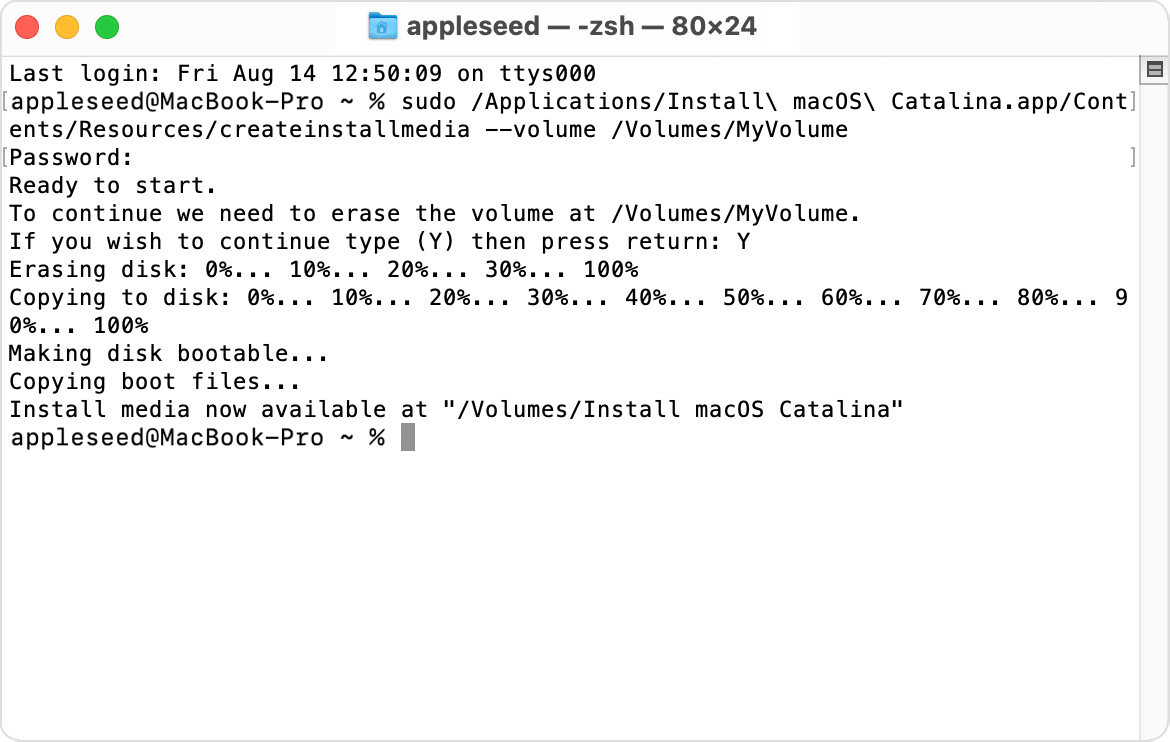Table of contents
1. How to use a USB flash drive to create a macOS boot disk
2. The conditions that need to be met to create a bootable installer
4. Use the "createinstallmedia" command in "Terminal"
1. How to use a USB flash drive to create a macOS boot disk
How to upgrade our Mac system or reinstall MacOS without using a USB boot disk, but if you want to install macOS on multiple computers and don’t want to download the installer every time, then the bootable installer will be useful .
At this time, we can use the U disk or the spare volume as the startup disk for installing the Mac operating system.
The following high-level steps are primarily intended for system administrators and others familiar with the command line.
2. The conditions that need to be met to create a bootable installer
- USB flash drive or other alternate volume (formatted as Mac OS Extended) with at least 14GB of free storage space
- Downloaded installers for macOS Monterey, Big Sur, Catalina, Mojave, High Sierra, or El Capitan
3. Download macOS
The installer for macOS Monterey, macOS Big Sur, macOS Catalina, macOS Mojave, or macOS High Sierra is downloaded to your Applications folder as an App named "Install macOS [version name]". If the installer is downloading , please exit without continuing the installation. To obtain the correct installer, follow these instructions:
- Please download from a Mac that is compatible with the corresponding version of macOS.
- Please download from a Mac running macOS Sierra 10.12.5 or later or OS X El Capitan 10.11.6.
- Enterprise Administrators: Please download from Apple rather than from a locally hosted software update server.
The installer for OS X El Capitan is downloaded to your Downloads folder as a disk image (named "InstallMacOSX.dmg"). To obtain the installer, follow the instructions below:
- Download using the Safari browser, then open the disk image on an OS X El Capitan-compatible Mac.
- Inside the disk image is an installer called "InstallMacOSX.pkg". It will install an app called "Install OS X El Capitan" in your Applications folder. You will create a bootable installer from this app (not from a disk image or .pkg installer).
4. Use the "createinstallmedia" command in "Terminal"
- Connect a USB flash drive or other volume where you want to hold the bootable installer.
- Open Terminal in the Utilities folder inside the Applications folder.
- Type or paste one of the following commands into Terminal. These commands assume that the installer is in your Applications folder and that "MyVolume" is the name of the USB flash drive or other volume you are using. If this is not the name, replace in these commands
MyVolumewith your volume name.
Monterey*:
sudo /Applications/Install\ macOS\ Monterey.app/Contents/Resources/createinstallmedia --volume /Volumes/MyVolume
Big Sur*:
sudo /Applications/Install\ macOS\ Big\ Sur.app/Contents/Resources/createinstallmedia --volume /Volumes/MyVolume
Catalina*:
sudo /Applications/Install\ macOS\ Catalina.app/Contents/Resources/createinstallmedia --volume /Volumes/MyVolume
Mojave*:
sudo /Applications/Install\ macOS\ Mojave.app/Contents/Resources/createinstallmedia --volume /Volumes/MyVolume
High Sierra*:
sudo /Applications/Install\ macOS\ High\ Sierra.app/Contents/Resources/createinstallmedia --volume /Volumes/MyVolume
Captain:
sudo /Applications/Install\ OS\ X\ El\ Capitan.app/Contents/Resources/createinstallmedia --volume /Volumes/MyVolume --applicationpath /Applications/Install\ OS\ X\ El\ Capitan.app
If your Mac is running macOS Sierra or earlier, use --applicationpath the arguments and installer path similar to how this is done in the command for El Capitan.
After typing the command:
- Press the Return key to enter this command.
- When prompted, type your administrator password, then press Return again. Terminal doesn't display any characters as you type your password.
- When prompted, type
Yto confirm that you want to erase the volume, then press Return. While the volume is being erased, Terminal will display the progress. - After the volume is erased, you may see an alert that Terminal wants to access files on the removable volume. Click OK to allow copying to continue.
- When Terminal says the operation is complete, the volume will have the same name as the installer you downloaded, such as "Install macOS Monterey". You can now exit Terminal and eject the volume.

5. Using a bootable installer
Determine if you have a Mac with an Apple silicon , and follow the appropriate steps:
Apple chip
- Plug the bootable installer into a Mac that is connected to the internet and is compatible with the version of macOS you want to install.
- The version of macOS that comes with your Mac is the earliest version it can work with.
- The bootable installer does not download macOS from the Internet, but does require an Internet connection to obtain firmware and other information specific to your Mac model.
- Turn on your Mac and continue to hold the power button until you see the Startup Options window, which shows Bootable Volumes.
- Select the volume containing the bootable installer, then click Continue.
- Once the macOS Installer opens, follow the on-screen instructions.
Intel processor
- Plug the bootable installer into a Mac that is connected to the internet and is compatible with the version of macOS you want to install.
- The version of macOS that comes with your Mac is the earliest version it can work with.
- The bootable installer does not download macOS from the Internet, but does require an Internet connection to obtain firmware and other information specific to your Mac model.
- Hold down the Option (Alt) ⌥ key immediately after turning on or restarting your Mac.
- Release the Option key when you see a black screen showing the bootable volume.
- Select the volume containing the bootable installer. Then click the up arrow or press Return.
If you cannot boot from a bootable installer, make sure the Boot Security Utility is set to allow booting from external or removable media. - Follow the prompts to choose your language.
- Select Install macOS (or Install OS X) from the Utilities window, then click Continue and follow the onscreen instructions.
6. Reference link
How to Create a Bootable macOS Installer - Apple Support (CA)